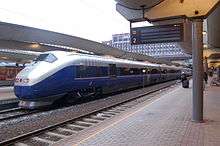Bergen Line
| Bergen Line | |
|---|---|
 Abandoned section of the line through Hardangervidda near Finse | |
| Overview | |
| Native name | Bergensbanen |
| Type | Railway |
| System | Norwegian railway |
| Termini |
Hønefoss[1] Bergen[1] |
| Stations | 39[2][3] |
| Operation | |
| Opened | 27 November 1909[4] |
| Owner | Norwegian National Rail Administration |
| Operator(s) |
Norwegian State Railways CargoNet Cargolink |
| Character |
Express trains Freight trains |
| Rolling stock | Class 73, El 18 |
| Technical | |
| Line length | 371 kilometres (231 mi)[1] |
| Number of tracks | Single[1] |
| Track gauge | 1,435 mm (4 ft 8 1⁄2 in)[5] |
| Electrification | 15 kV 16 2⁄3 Hz AC |
| Operating speed | Max. 160 kilometres per hour (99 mph) |
| Highest elevation | 1,237 metres (4,058 ft)[6] |
The Bergen Line (Norwegian: Bergensbanen or Bergensbana), also called the Bergen Railway, is a 371-kilometre (231 mi) long standard gauge railway line between Bergen and Hønefoss, Norway.[1] The name is often applied for the entire route from Bergen via Drammen to Oslo, where the passenger trains go, a distance of 496 kilometres (308 mi).[7] It is the highest mainline railway line in Northern Europe,[8] crossing the Hardangervidda plateau at 1,237 metres (4,058 ft) above sea level.[6]
The railway opened from Bergen to Voss in 1883 as the narrow gauge Voss Line. In 1909 the route was continued over the mountain to Oslo and the whole route converted to standard gauge, and the Voss Line became part of the Bergen Line.[9] The line is single track,[1] and was electrified in 1954-64.[10] The Bergen Line is owned and maintained by the Norwegian National Rail Administration, and served with passenger trains by Norwegian State Railways (NSB) and freight trains by CargoNet. The Flåm Line remains as the only branch line, after the closure of the Hardanger Line.[1] The western section from Bergen to Voss is also served by the Bergen Commuter Rail, and was shortened following the 1966 opening of the Ulriken Tunnel.
History
First step to Voss

The first documented idea of building a railway between Norway's two largest cities was launched by Hans Gløersen on 24 August 1871 in Bergensposten. The forest supervisor in Voss suggested building the railway via Voss and Hallingdal to connect with the Krøderen Line. Back in 1866 the same person had launched the idea of the Jæren Line. Within days of the launch of the Bergen Line the city council had assimilated support for the suggestion. In 1872 the railway director Carl Abraham Pihl and two engineers went on a survey tour to look at the suggested line.[11] At the time it was common that proposals for railways came from local initiative, and that local municipalities and private investors would then pay about 20% of the investments, the state covering the rest, mostly through foreign debt.[12]
Political processes
On 20 October 1871 two engineers traversed the two possible routes from Bergen to Voss; the one via Fana, Os and Hardangerfjord, the other via Dale and Sørfjord. Though covering a less populated area, the latter would be cheaper to build, and have less elevation. A railway committee was created on 25 January 1872 with a limited mandate, which was increased again 20 December. At the same time there was a dispute between the Ministry of Labour and Pihl about whether to prioritize the Bergen Line, but in July 1872 surveys were performed in person by Pihl and two engineers, and their report was positive. At the same time he launched the idea of a branch line up Valdres to Lærdal.[13]
By 1873 agreement had been reached as to the right-of-way to Voss, but not onwards towards Oslo. On 13 January 1874 Bergen city council started issuing stock for the Voss Line, to begin with 400,000 Norwegian speciedaler (NOK 1.6 million) was issued. In the 1873 parliamentary election the railway supporter Peter Jebsen was elected, spending the next few years furiously defending the railway. Parliament chose to not issue new railway projects in the 1874 session, and instead make a complete plan for all railway construction in the country—to be proposed by a committee. When the report was launched on 20 March 1875, the Voss Line was not included since it could not show a higher profitability than 1%. During the 1875 session there was not a majority for the Voss Line, partially due to the lack of capital available for local investors. This was based on a claim from Johan Jørgen Schwartz, the chairman of the committee, that the investment costs were underestimated. This was countered by Nils Henrik Bruun, a constructor from Bergen, who was willing to construct all tunnels on the railway for less than the budgeted sum. When Jebsen in addition was willing to act as personal guarantee for Bruun in case of his death, the majority in the parliament shifted. On 9 June 1875 parliament voted with 61 against 42 to build Vossebanen.[14]
Construction

Vossebanen was built with narrow gauge, 1,067 mm (3 ft 6 in). The first parts of the construction started in December 1875, while the largest part started in March 1876. During the winter the engineers had done the last finesses on the plans. At any given time at least 800 men worked on construction,[15] and at the peak 1,800 men were employed.[16] They worked 12 hours per day, for which they had a daily wage of NOK 2.55, the highest wage for navvies in the country.[17] To a large extent the labor came from Sweden, who had just finished the Norway/Väneren Line and had an excess of skilled labor for construction. This import of labor had the effect of pumping money into the local economy, and several taverns were built along the line. There were some accidents, and several deaths among the workers.[18]
The construction work was finished in 1882 and some test services began, though not scheduled until the spring of 1883. Official opening commenced on 11 July 1883. Many of the navvies settled on Vossebanen after construction, and started working for the NSB as part of the operation.[19]
Across the mountain
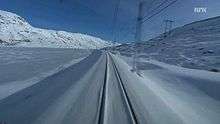
By the time the Voss Line was completed Norway had plunged into recession. Parliament was not willing to give more money to railways, and the country had to make do with a transport plan launched in 1886 that did not follow up with any funding. On 1 March 1894 parliament after five days of debate chose, with 60 against 53 votes, to build the Bergen Line.[20] Several different routes had been proposed, including over Krøderen, or down Numedal (which later would get the Numedal Line). In the end Hallingdal was chosen, connecting to Hønefoss and via Sandvika. To save costs a preliminary line would connect Hønefoss to Roa with the branch Roa–Hønefoss Line. The final stage would be along the Gjøvik Line to Oslo. The line would also connect to the system via the Randsfjorden Line at Hønefoss.
Local financing was ready within a year, yet it took six years to survey the line properly, and construction start had to wait until 1901.[21] Construction started with the building of roads to get in supplies to the construction sites, completed in 1902. The construction was exceptionally challenging, at high altitudes in a region without roads and with a climate that saw many meters of snow in the winter and temperatures far below freezing.[22] 113 tunnels, totaling 28 kilometres (17 mi) had to be built; the longest being the 5,311 metres (17,425 ft) Gravehalsen Tunnel, alone costing NOK 3 million and the longest tunnel north of the Alps. It took six years to build, and had to be excavated manually through solid gneiss.[23] Laying of track was started in 1906, and in 1907 the two groups, both having started at their own end, met at Ustaoset. A small celebration was made at the spot (see image).
It had been decided that the Bergen Line, unlike the Voss Line, was to be built with standard gauge. So the newly laid line from Bergen to Voss had to be converted in time for the opening of the Bergen Line. This was especially challenging because of the continuous traffic on the line, with 36 departures per day to Nesttun, six to Garnes and four to Voss. In preparation a few curves had to be straightened, the tunnels widened and the bridges strengthened. On the night of 10/11 August 1904 all the track was changed and in the morning the trains could operate on standard gauge to Voss.[24]
The first services started on 1 July 1907 from Voss to Myrdal. An official opening train attempted to cross part of the line to Gulsvik on 9 December 1907, but got stuck in heavy snow and had to return. It turned out that the railway had to close and it took one and a half month to clear it for snow. Even a rotary snowplow at 750 kW was not powerful enough to get rid of the snow. A new attempt to open the line in 1908 succeeded, and a train went from Gulsvik to Bergen. The line from Roa to Gulsvik was still under construction, so passage was along the Drammen Line via the Krøder Line with ship over Krøderen to Gulsvik. The first scheduled train from Oslo West Station en route to Bergen departed 10 June 1908.[25]
On 25 November 1909 a train en route from Bergen rolled into Oslo Østbanestasjon, and two days later the railway was officially opened at Voss. King Haakon VII stated upon the opening that the line was the Norwegian engineering masterpiece of his generation.[26]

Steaming up
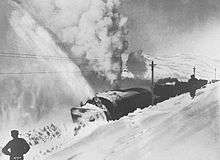
World War II was a demanding time for the railway line, as the track was in heavy use for both civilian and military transportation, and much of the equipment and maintenance was lacking. On 28 February 1944 a descending eastbound freight train loaded with oil and petrol lost its braking power and became a runaway train, finally ploughing into a westbound passenger train at Breifoss, just east of Geilo. The crash and subsequent fire killed 25 civilians and an unknown number of German soldiers. Poor lubrication oil combined with the cold weather is believed to have caused the accident.
Electrification

Norway is a country with abundance of hydroelectricity and NSB saw huge amounts of money burning up with the imported coal. Plans for electrification of the line is as old as the railway itself, and in 1912 the line from Nesttun to Bergen was proposed electrified and rebuilt to double track,[27] having seen the Thamshavn Line open with electric traction in 1908.[9] During the planning of the Hardanger Line and the Flåm Line during the 30s the suggestion again arose, and both the branch lines were built with electric traction, but not the main line. Countersuggestions were raised proposing a conversion to the locomotives running on oil or coal dust. In 1939 a plan for national electrification was launched, and the Voss Line was top priority. But the breakout of World War II set the plans back, and not until the 50s was it again possible to afford such investments.[28] Vossebanen took electric traction into use on 2 July 1954.[9]
In 1952 a new plan was launched by parliament to electrify 1,153 kilometres (716 mi) of railway, with the line from Voss to Hønefoss prioritized fourth. The following year NSB launched the "away with the steam"-campaign, that would replace all steam locomotives with electric or diesel traction. Since electrification was not imminent, NSB introduced diesel traction on the Bergen Line in 1958, predominantly using Di 3 stock. Travel time between the two termini was reduced by about one hour. During summer the Class 66 diesel multiple units were put into service, but they were not heavy enough to cope with winter and thus only served during the summer months.[29] The line was electrified in four stages, from Roa to Hønefoss on 1 February 1961, from Hønefoss to Ål on 1 December 1962, from Ål to Ustaoset on 15 December 1963 and finally from Ustaoset to Voss on 7 December 1964.[9] As the point of electrification moved across the mountain, so did the point NSB changed locomotive on the train. The new locomotive El 13 was put into service on the electric parts. The electrification cost NOK 143 million.[30]
The express trains have as one of the main lines always been allocated the newest locomotives by NSB. When the El 14 was delivered in 1968,[31] it was put into service on Bergensbanen, as was the El 16 in 1977,[32] the El 17 in 1981,[33] and finally the El 18 in 1996.[34] The older locomotives have been relegated to freight service. In 2000 electric multiple units were put into service with the Class 73 tilting trains, branded as Signatur and capable of 210 kilometres per hour (130 mph). However, they cannot be used at those speed on any part of the Bergen Line, and only some parts of the Asker Line and around Finse can they operate quicker than the locomotive hauled trains.[35] There has also been reason to doubt their winter capability on the very demanding Bergen Line. Occasionally they have been stuck in the snow,[36] and on February 21, 2007 a multiple unit derailed after running into a pack of snow.[37] As refurbished carriages become available, the multiple units will be removed from the line, and replaced by traditional locomotive-hauled trains.[38]
Through the first mountain
The first 32 kilometres (20 mi) form Bergen to Takvam represented a very roundabout way, and it was clear that it would be possible to reduce the line by 21 kilometres (13 mi) with the construction of three tunnels, Ulriken Tunnel (7,660 metres or 25,130 feet), Arnanipa Tunnel (2,177 metres or 7,142 feet) and Tunestveit Tunnel (40 metres or 130 feet).[39] The idea was approved by parliament in 1956, based on private financing from the businessman Fritz Rieber. Construction started in 1959 with the tunnels being finished in 1963 while the tracks were finished laid on 29 May 1964 when the first train entered the tunnel.[40]
Rieber has suggested a package for the politicians, where he would create a company that would borrow money to build both the Ulriken Tunnel, a shortening of the line from Hønefoss to Sandvika (the Ringerike Line) and electrify the railway. Since NSB based their fares on the route length traveled, financing would be covered by a surcharge equal to the distance saved; ticket price would remain the same and within twenty years the debt would be covered. The government opposed the suggestion—Trygve Bratteli commenting that even though the financing was private, it would still have to use the same funding as government debt, and would jeopardize other projects, like the Nordland Line.[41]
In 1980 the Oslo Tunnel was opened, allowing trains along the Drammen Line to go to the new Oslo Central Station, an upgrade of the former Oslo Ø. As a consequence of this, passenger trains were since the late 1980s rerouted via Drammen instead of via Roa, following the Drammen Line and the Randsfjord Line to Hønefoss. This allows the trains to pass through more densely populated areas and on trackage with more capacity. However, the change of route actually increased the length between the two termini by 23 kilometres (14 mi). But the better track standard via Drammen results in about the same travel time. Freight trains still goes via Roa.[42]
Lowering the peak
| Haugastøl-Hallingskeid | |||||||||||||||||||||||||||||||||||||||||||||||||||||||||||||||||||||||||||||||||||||||||||
|---|---|---|---|---|---|---|---|---|---|---|---|---|---|---|---|---|---|---|---|---|---|---|---|---|---|---|---|---|---|---|---|---|---|---|---|---|---|---|---|---|---|---|---|---|---|---|---|---|---|---|---|---|---|---|---|---|---|---|---|---|---|---|---|---|---|---|---|---|---|---|---|---|---|---|---|---|---|---|---|---|---|---|---|---|---|---|---|---|---|---|---|
Legend
| |||||||||||||||||||||||||||||||||||||||||||||||||||||||||||||||||||||||||||||||||||||||||||

During winter NSB had large costs keeping the line snow-free. Large diesel-electric snowploughs were stationed at Finse, and tens of kilometers of snow sheds were built on the most vulnerable parts. Especially the 22 kilometres (14 mi) part between Finse Station and Hallingskeid was a drain on resources, and heavy snowfall and drifts regularly closed the entire line. A solution was proposed by NSB's director Robert Nordén in 1984, involving construction of a 10.5 kilometres (6.5 mi) tunnel between the two stations.[43]
In 1989 the Parliament of Norway approved the plans, including the upgrade of part of the line east of Finse. In total NOK 750 million was invested in rebuilding 32 kilometres (20 mi) of line, shortening it by 4.5 kilometres (2.8 mi). At the same time the permitted speed could be increased from 70 kilometres per hour (43 mph) to 170 kilometres per hour (110 mph). The tunnel opened on 16 June 1992 while the rest of the upgrades opened in five steps in the period 1995–98. The highest point of the line was reduced from 1,301 metres (4,268 ft) to 1,237 metres (4,058 ft)—located inside the tunnel.[43] After the opening the base for snow removal was closed at Finse.[44]
Operation
The Bergen Line as a through line is used for up to five express trains operated by Norwegian State Railways, as well as freight trains by CargoNet. From Myrdal to Bergen there are commuter rail services operated by NSB.
Line
The total distance from Oslo to Bergen via Drammen is 493 kilometres (306 mi), while the Bergen Line proper is 372 kilometres (231 mi).[1] The line has 182 tunnels,[1] totaling ca. 73 kilometres (45 mi), of which ten are over 2.0 kilometres (1.2 mi).[45] Finse Station remains the highest elevated station at 1,222.2 metres (4,010 ft), while the highest point is in the Finse Tunnel at 1,237 metres (4,058 ft).[6]
Commuter rail
NSB operates a commuter rail service from Bergen with two hourly departures to Arna, plus fourteen daily departures to Voss, of which up to six continue to Myrdal. Rolling stock is the Class 69 multiple units.[46] The first part to Arna represents an important part of the public transport in Bergen, since the rail direct line through the mountain Ulriken is considerably faster than driving around.
Express service
Express trains operated by NSB have always been the primary passenger service on Bergensbanen. Passenger trains follow the Drammen Line and the Asker Line to Drammen, before heading north to Hønefoss on the Randsfjord Line. The express trains offer both transport from villages along the line to either Bergen or Oslo, as well travel between Norway's two largest cities. Up to two day trains are provided with Class 73 multiple units, while the remaining services are with locomotive hauled trains. Six nights a week there is a night train service. Several parts of the line service places without road access, such as Finse and Myrdal.[47] Operating deficits are covered by the Norwegian Ministry of Transport and Communications.[48]
Freight
Freight trains are operated by CargoNet, hauled by El 14 and El 16 locomotives. Most transport is from the terminal at Alnabru in Oslo to the terminal at Bergen Station. Freight trains use the Roa-Hønefoss Line instead of going via Drammen since it is shorter—distance is more important than speed for freight trains. CargoNet operates up to four daily trains from Oslo, plus one from Drammen.[49] Rail freight on Bergensbanen increased by 80% from 2001–05, but further growth is not possible without better infrastructure; CargoNet has indicated they want five more passing loops, as well as extending them to increase train length from 400 metres (1,300 ft) to 600 metres (2,000 ft), claiming they could double freight traffic with adequate infrastructure.[50][51]
Heritage
Parts of the closed sections of Vossebanen, from Midttun to Garnes has been converted to a heritage railway—the Old Voss Line—that is operated with steam trains by the Norwegian Railway Club during the summer.[52] At Finse there is a navvy museum, and the old navvy road has become a cycle track.[53]
The branch Flåm Line has been converted to a tourist route. The railway has spectacular scenery and a vertical descent of 864 metres (2,835 ft) or 5.5% along the 20 kilometres (12 mi) route from Myrdal to Flåm. Operation is still performed by NSB, but marketing is performed by Flåm Utvikling.[54] The stock used on the railway are El 17 hauling B3 wagons, all painted green.[55]
Future propositions
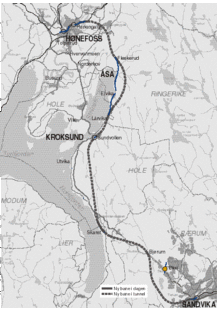
Closing
In 2002 the Norwegian National Rail Administration warned that lack of funding might lead to a closure of all long-distance passenger trains in Norway, including the Bergen Line. Torild Skogsholm, Minister of Transport and Communications assured that it was not the government's policy to close railway lines.[56] In 2004 the Progress Party suggested closing down the railway line and replacing it with a motorway between Bergen and Oslo, arguing that the railway was unprofitable, and that bus transport was cheaper while easier truck transport would aid business. Other political parties rejected the proposal pointing out the better environmental performance of the railway and that the railway transports large volumes of freight.[57] On 16 June 2011, a welding accident caused a fire at Hallingskeid Station, causing the complete destruction of the platform. This caused a temporary closure of the line until 23 June 2011.[58]
Upgrades
Ulriken Tunnel represents the largest bottleneck on the Bergen Line, due to the commuter trains to Arna. Building double track on the westernmost part of Bergensbanen would free up capacity not only of that part of the line, but the whole line across the mountains.[59]
The original plans for Bergensbanen from 1894 included the construction of a new line—the Ringerike Line—from Hønefoss to Sandvika just west of Oslo. This line would reduce the distance on Bergensbanen by 60 kilometres (37 mi) and 50 minutes travel time. There has been a continual decision to build this railway line, but it has never received any funding.[60] These plans were discussed more after 2000, and a detailed plan has been done. Combined with other improvements totaling investments of NOK 7 billion, travel time could be reduced to four and a half hours.[61] The project is scheduled to be built between 2019 and 2024.
High-speed rail
Several suggestions for high-speed rail from Oslo to Bergen have been launched. Preliminary studied performed for the National Rail Administration with positive cost-benefit ratios on building high-speed rail from Oslo to Bergen. The most suitable route would approximately follow the existing route (but a new tunnel Oslo–Hønefoss). Oslo–Trondheim and Oslo–Halden are assumed to be built earlier because of lower cost.[62] Two lobbyist suggestions to the route have also been launched. The one involves a "high-speed ring" from Oslo, via Numedal to Geilo, then following Bergensbanen to Bergen and continuing south to Stavanger and back to Oslo via Kristiansand.[63] Norsk Bane has launched the idea of building a common line from Oslo to Haukeli and then from branching off to Bergen and Stavanger.[64]
Such long-distance high-speed railways are not included in the preliminary long-term plan for 2010–2040, and it is likely that railways Hamar–Trondheim and Drammen–Kristansand will be built first since they are easier to build. It is likely that a high-speed railway to Bergen will be built sometime in the period 2030–2060.
Stations
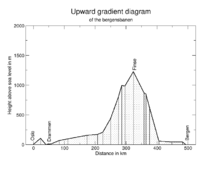
Bergensbanen | |||||||||||||||||||||||||||||||||||||||||||||||||||||||||||||||||||||||||||||||||||||||||||||||||||||||||||||||||||||||||||||||||||||||||||||||||||||||||||||||||||||||||||||||||||||||||||||||||||||||||||||||||||||||||||||||||||||||||||||||||||||||||||||||||||||||||||||||||||||||||||||||||||||||||||||||||||||||||||||||||||||||||||||||||||||||||||||||||||||||||||||||||||||||||||||||||||||||||||||||||||||||||||||||||||||||||||||||||||||||||||||||||||||||||||||||||||||||||||||||||||||||||||||||||||||||||||||||||||||||||||||||||||||||||||||||||||||||||||||||||||||||||||||||||||||||||||||||||||||||||||||||||||||||||||||||||||||||||||||||||||||||||||||||||||||||||||||||||||||||||||||||||||||||||||||||||||||||||||||||||||||||||||||||||||||||||||||||||||||||||||||||||||||||||||||||||||||||||||||||||||||||||||||||||||||||||||||||||||||||||||||||||||||||||||||||||||||||||||||||||||||||||||||||||||||||||||||||||||||||||||||||||||||||||||||||||||||||||||||||||||||||||||||||||||||||||||||||||||||||
|---|---|---|---|---|---|---|---|---|---|---|---|---|---|---|---|---|---|---|---|---|---|---|---|---|---|---|---|---|---|---|---|---|---|---|---|---|---|---|---|---|---|---|---|---|---|---|---|---|---|---|---|---|---|---|---|---|---|---|---|---|---|---|---|---|---|---|---|---|---|---|---|---|---|---|---|---|---|---|---|---|---|---|---|---|---|---|---|---|---|---|---|---|---|---|---|---|---|---|---|---|---|---|---|---|---|---|---|---|---|---|---|---|---|---|---|---|---|---|---|---|---|---|---|---|---|---|---|---|---|---|---|---|---|---|---|---|---|---|---|---|---|---|---|---|---|---|---|---|---|---|---|---|---|---|---|---|---|---|---|---|---|---|---|---|---|---|---|---|---|---|---|---|---|---|---|---|---|---|---|---|---|---|---|---|---|---|---|---|---|---|---|---|---|---|---|---|---|---|---|---|---|---|---|---|---|---|---|---|---|---|---|---|---|---|---|---|---|---|---|---|---|---|---|---|---|---|---|---|---|---|---|---|---|---|---|---|---|---|---|---|---|---|---|---|---|---|---|---|---|---|---|---|---|---|---|---|---|---|---|---|---|---|---|---|---|---|---|---|---|---|---|---|---|---|---|---|---|---|---|---|---|---|---|---|---|---|---|---|---|---|---|---|---|---|---|---|---|---|---|---|---|---|---|---|---|---|---|---|---|---|---|---|---|---|---|---|---|---|---|---|---|---|---|---|---|---|---|---|---|---|---|---|---|---|---|---|---|---|---|---|---|---|---|---|---|---|---|---|---|---|---|---|---|---|---|---|---|---|---|---|---|---|---|---|---|---|---|---|---|---|---|---|---|---|---|---|---|---|---|---|---|---|---|---|---|---|---|---|---|---|---|---|---|---|---|---|---|---|---|---|---|---|---|---|---|---|---|---|---|---|---|---|---|---|---|---|---|---|---|---|---|---|---|---|---|---|---|---|---|---|---|---|---|---|---|---|---|---|---|---|---|---|---|---|---|---|---|---|---|---|---|---|---|---|---|---|---|---|---|---|---|---|---|---|---|---|---|---|---|---|---|---|---|---|---|---|---|---|---|---|---|---|---|---|---|---|---|---|---|---|---|---|---|---|---|---|---|---|---|---|---|---|---|---|---|---|---|---|---|---|---|---|---|---|---|---|---|---|---|---|---|---|---|---|---|---|---|---|---|---|---|---|---|---|---|---|---|---|---|---|---|---|---|---|---|---|---|---|---|---|---|---|---|---|---|---|---|---|---|---|---|---|---|---|---|---|---|---|---|---|---|---|---|---|---|---|---|---|---|---|---|---|---|---|---|---|---|---|---|---|---|---|---|---|---|---|---|---|---|---|---|---|---|---|---|---|---|---|---|---|---|---|---|---|---|---|---|---|---|---|---|---|---|---|---|---|---|---|---|---|---|---|---|---|---|---|---|---|---|---|---|---|---|---|---|---|---|---|---|---|---|---|---|---|---|---|---|---|---|---|---|---|---|---|---|---|---|---|---|---|---|---|---|---|---|---|---|---|---|---|---|---|---|---|---|---|---|---|---|---|---|---|---|---|---|---|---|---|---|---|---|---|---|---|---|---|---|---|---|---|---|---|---|---|---|---|---|---|---|---|---|---|---|---|---|---|---|---|---|---|---|---|---|---|---|---|---|---|---|---|---|---|---|---|---|---|---|---|---|---|---|---|---|---|---|---|---|---|---|---|---|---|---|---|---|---|---|---|---|---|---|---|---|---|---|---|---|---|---|---|---|---|---|---|---|---|---|---|---|---|---|---|---|---|---|---|---|---|---|---|---|---|---|---|---|---|---|---|---|---|---|---|---|---|---|---|---|---|---|---|---|---|---|---|---|---|---|---|---|---|---|---|---|---|---|---|---|---|---|---|---|---|---|---|---|---|---|---|---|---|---|---|---|---|---|---|---|---|---|---|---|---|---|---|---|---|---|---|---|---|---|---|---|---|---|---|---|---|---|---|---|---|---|---|---|---|---|---|---|---|---|---|---|---|---|---|---|---|---|---|---|---|---|---|---|---|---|---|---|---|---|---|---|---|---|---|---|---|---|---|---|---|---|---|---|---|---|---|---|---|---|---|---|---|---|---|---|---|---|---|---|---|---|---|---|---|---|---|---|---|---|---|---|---|---|---|---|---|---|---|---|---|---|---|---|---|---|---|---|---|---|---|---|---|---|---|---|---|---|---|---|---|---|---|---|---|---|---|---|---|---|---|---|---|---|---|---|---|---|
Legend
| |||||||||||||||||||||||||||||||||||||||||||||||||||||||||||||||||||||||||||||||||||||||||||||||||||||||||||||||||||||||||||||||||||||||||||||||||||||||||||||||||||||||||||||||||||||||||||||||||||||||||||||||||||||||||||||||||||||||||||||||||||||||||||||||||||||||||||||||||||||||||||||||||||||||||||||||||||||||||||||||||||||||||||||||||||||||||||||||||||||||||||||||||||||||||||||||||||||||||||||||||||||||||||||||||||||||||||||||||||||||||||||||||||||||||||||||||||||||||||||||||||||||||||||||||||||||||||||||||||||||||||||||||||||||||||||||||||||||||||||||||||||||||||||||||||||||||||||||||||||||||||||||||||||||||||||||||||||||||||||||||||||||||||||||||||||||||||||||||||||||||||||||||||||||||||||||||||||||||||||||||||||||||||||||||||||||||||||||||||||||||||||||||||||||||||||||||||||||||||||||||||||||||||||||||||||||||||||||||||||||||||||||||||||||||||||||||||||||||||||||||||||||||||||||||||||||||||||||||||||||||||||||||||||||||||||||||||||||||||||||||||||||||||||||||||||||||||||||||||||||
| Station | Elevation (m)[2] | Distance from Oslo (km) |
Distance from Bergen (km) | |
|---|---|---|---|---|
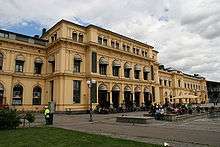 |
Oslo S | 2 | 0 | 493 |
 |
Asker | 104 | 24 | 469 |
 |
Drammen | 2 | 41 | 452 |
 |
Hokksund | 8 | 58 | 435 |
 |
Vikersund | 67 | 84 | 409 |
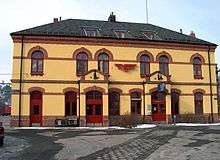 |
Hønefoss | 96 | 112 | 381 |
| Flå | 155 | 174 | 319 | |
 |
Nesbyen | 168 | 208 | 285 |
| Gol | 207 | 225 | 268 | |
 |
Ål | 436 | 250 | 243 |
 |
Geilo | 794 | 275 | 218 |
 |
Ustaoset | 990 | 286 | 207 |
 |
Haugastøl | 988 | 297 | 196 |
 |
Finse | 1222 | 324 | 169 |
 |
Hallingskeid | 1110 | 345 | 148 |
| Myrdal | 867 | 358 | 135 | |
 |
Upsete | 850 | 364 | 129 |
 |
Mjølfjell | 627 | 376 | 117 |
 |
Voss | 57 | 407 | 86 |
 |
Dale | 43 | 447 | 46 |
| Arna | 8 | 483 | 10 | |
 |
Bergen | 2 | 493 | 0 |
References
Notes
- 1 2 3 4 5 6 7 8 9 Jernbaneverket, 2007: 6
- 1 2 "Oslo - Bergen, Bergensbanen". Norwegian National Rail Administration. Archived from the original on October 15, 2007. Retrieved 2008-05-29.
- ↑ "Bergen - Voss - Myrdal". Norwegian National Rail Administration. Archived from the original on October 15, 2007. Retrieved 2008-05-29.
- ↑ Holøs, 1984:73
- ↑ Holøs, 1984: 63
- 1 2 3 Rødland, 1999: 30
- ↑ Jernbaneverket, 2007: 13
- ↑ Finse Tunnel is the highest point in Bergensbanen, in "Finse". Bergens Tidende. Retrieved 2008-06-03. which is the highest railway in Northern Europe "Norway in a Nutshell - Norway's most popular round trip tour". Norgate Online. 12 March 2008. Retrieved 2008-06-03.
- 1 2 3 4 Jernbaneverket, 2007: 44
- ↑ Jernbaneverket, 2006: 33
- ↑ Gubberud, 1983: 16–17
- ↑ Gubberud, 1983: 17–19
- ↑ Gubberud, 1983: 19–21
- ↑ Gubberud, 1983: 21–27
- ↑ Gubberud, 1983: 30
- ↑ Holøs, 1984: 18
- ↑ Hille, L. M. (1881-06-07). "Dagslønn". Bergens Aftenblad.
- ↑ Gubberud, 1983: 32
- ↑ Gubberud, 1983: 32–33
- ↑ Holøs, 1984: 28–30
- ↑ Holøs, 1984: 31
- ↑ Holøs, 1984: 33–34
- ↑ Holøs, 1984: 38–43
- ↑ Holøs, 1984: 63–64
- ↑ Holøs, 1984: 63-69
- ↑ Holøs, 1984: 73-75
- ↑ Holøs, 1984: 93
- ↑ Hobøl, 1984: 93–95
- ↑ Holbø, 1984: 95–98
- ↑ Rødland, 1999: 103
- ↑ Aspenberg, 2001: 102
- ↑ Aspenberg, 2001: 115
- ↑ Aspenberg, 2001: 118
- ↑ Aspenberg, 2001: 122
- ↑ Aspenberg, 2001: 188
- ↑ Norsk Rikskringkasting. "Snø stanser Signatur-togene" (in Norwegian). Archived from the original on 2007-03-01. Retrieved 2007-03-20.
- ↑ Bergens Tidende. "Tåler ikke snøfonner" (in Norwegian). Retrieved 2007-02-22.
- ↑ Attende til framtida "Attende til framtida" Check
|url=value (help) (in Norwegian). Bergen: Bergens Tidende. 24 November 2008. Retrieved 2009-11-29. - ↑ Norsk Jernbaneklubb, 1994
- ↑ Holøs, 1984: 101–02
- ↑ Rødland, 1999: 98–102
- ↑ Jernbaneverket. "Hønefoss stasjon" (in Norwegian). Retrieved 2008-05-29.
- 1 2 Rødland, 1999: 15–34
- ↑ Jernbaneverket. "Finse stasjon" (in Norwegian). Retrieved 2008-05-28.
- ↑ Jernbaneverket, 2007: 26
- ↑ Norges Statsbaner (2008). "Bergen - Voss - Myrdal" (PDF). Retrieved 2008-05-29.
- ↑ Norges Statsbaner (2008). "Oslo S-Bergen" (PDF). Archived from the original (PDF) on 2008-09-20. Retrieved 2008-05-29.
- ↑ Norwegian Ministry of Transport and Communications (2007-01-23). "Avtale om utførelse av persontransport med tog" (PDF) (in Norwegian). Archived from the original (PDF) on 2011-05-21.
- ↑ CargoNet (2008-01-06). "Produktblad Bergen" (PDF) (in Norwegian).
- ↑ Hallingdølen. "Vil satse milliarder på gods" (in Norwegian). Archived from the original on February 18, 2012. Retrieved 2008-06-03.
- ↑ Institute of Transport Economics (2006). "Mer gods på jernbane - et spørsmål om kvalitet" (in Norwegian).
- ↑ Norsk Jernbaneklubb. "Gamle Vossebanen Steam Railway". Retrieved 2008-05-29.
- ↑ Rallarmuseet. "Rallarmuseet" (in Norwegian). Retrieved 2008-05-29.
- ↑ Flåm Utvikling. "The Flåm Railway". Retrieved 2008-05-29.
- ↑ Aspenberg, 2001: 118–21
- ↑ NRK Sør-Trøndelag (2002-02-28). "Skjebnevalg for norsk jernbane Choice of fate for Norwegian Railways" (in Norwegian). Archived from the original on 2012-02-24.
- ↑ Bergens Tidende (2004-01-16). "Frp: - Steng Bergensbanen (Progress Party: "Close the Bergen Railway")" (in Norwegian).
- ↑ "Investigation underway into train fire : Views and News from Norway". Newsinenglish.no. 2011-06-17. Retrieved 2012-08-15.
- ↑ Jernbaneverket (2008). "Konsekvcensutredning Arna - Fløen" (PDF) (in Norwegian). Archived from the original (PDF) on 2007-12-18.
- ↑ Jernbaneverket. "Bergensbanens forkortelse, Ringeriksbanen" (in Norwegian). Archived from the original on April 27, 2008. Retrieved 2008-05-28.
- ↑ Jernbaneverket. "Rask og effektiv Bergensbane for sju milliarder" (in Norwegian). Archived from the original on July 21, 2007. Retrieved 2008-05-28.
- ↑ Norwegian National Rail Administration (2008-05-13). "Highspeed -lines: Further steps should be taken".
- ↑ Høyhastighetsringen. "Høyhastighetsringen" (in Norwegian). Retrieved 2008-05-28.
- ↑ Norsk Bane. "Haukelibanen" (in Norwegian). Archived from the original on 2007-08-03. Retrieved 2008-05-28.
Bibliography
- Aspenberg, Nils Carl (2001). Elektrolok i Norge (in Norwegian). Oslo: Baneforlaget. ISBN 82-91448-42-6.
- Gubberud, Ivar J. (1983). Vossebanen 1883-1983 (in Norwegian). Oslo: Norsk Jernbaneklubb. ISBN 82-90286-05-8.
- Holøs, Bjørn (1984). Bergensbanen 75 (in Norwegian). Oslo: Gyldendal. ISBN 82-05-19349-5.
- Jernbaneverket (2007). Jernbanestatistikk 2006 (PDF). Oslo: Jernbaneverket.
- Norsk Jernbaneklubb (1994). Banedate '94. Oslo: Norsk Jernbaneklubb. ISBN 82-90286-15-5.
- Rødland, Kjartan (1999). Bergensbanen: livsnerven over høyfjellet (in Norwegian). Bergen: Alma Mater. ISBN 82-419-0253-0.
External links
-
 Media related to Bergensbanen at Wikimedia Commons
Media related to Bergensbanen at Wikimedia Commons - The Bergen Line (Bergensbanen) NSB (English)
- Jernbaneverket entry
- Norsk Jernbaneklubb entry
- 7.5 Hour documentary of the train journey (HD)
- The railway tour in Google Earth (with references to the 7.5 hour documentary)
- Video game that uses the 7.5 hour documentary
- "Damplokomotiv på Bergensbanen Se de sjeldne opptakene fra Bergensbanen på 30-tallet." ["Locomotive on the Bergen Line - See the film clips from the 1930s"]
- Banen som kan gjøre Voss til by [The railway that can turn Voss into a city]
Coordinates: 60°20′16″N 7°49′20″E / 60.33778°N 7.82222°E
